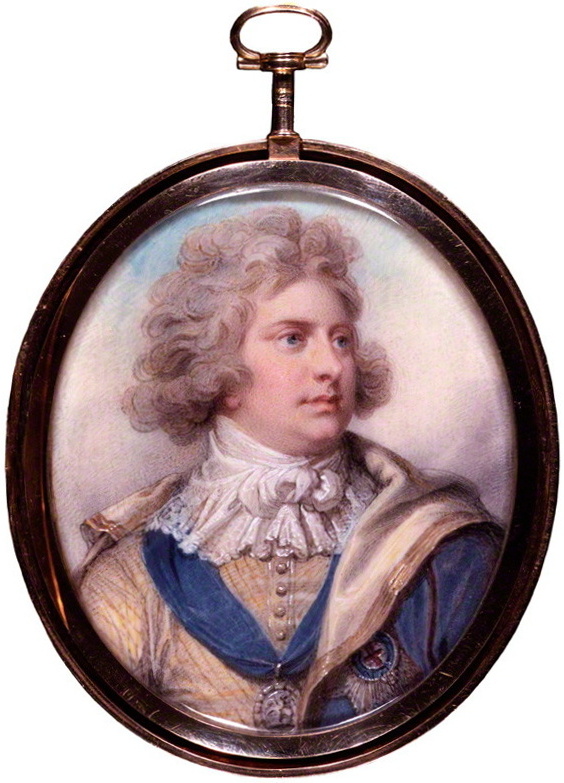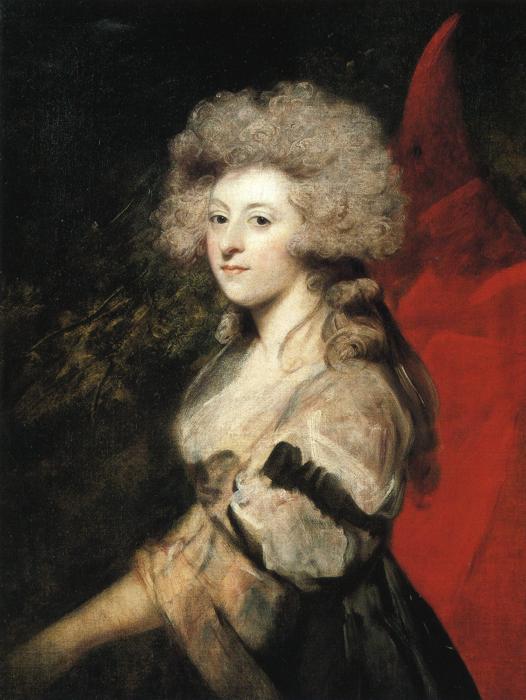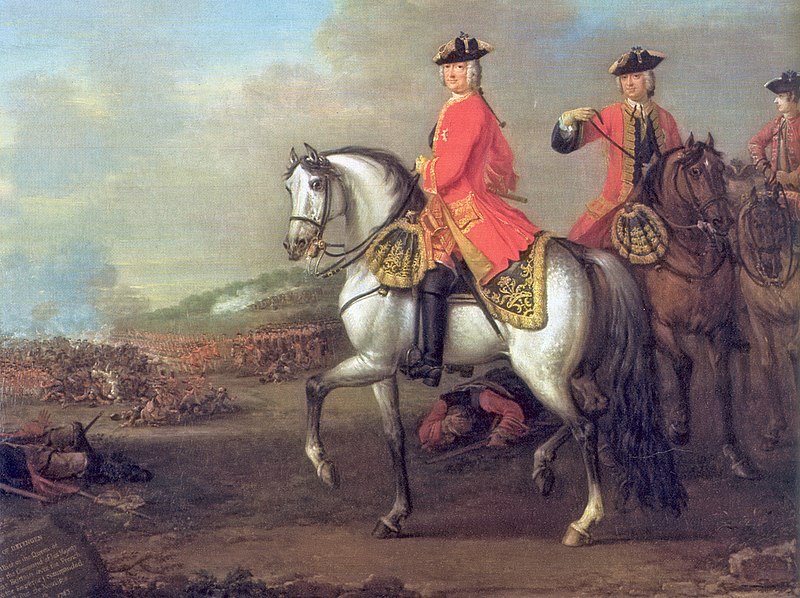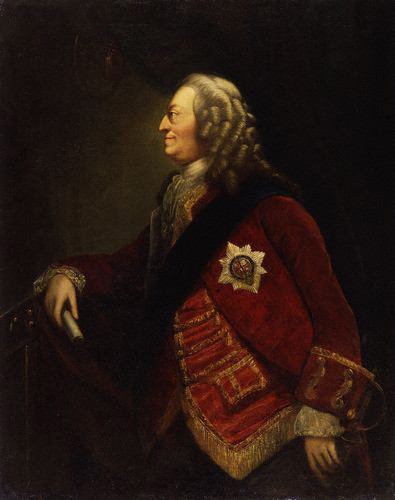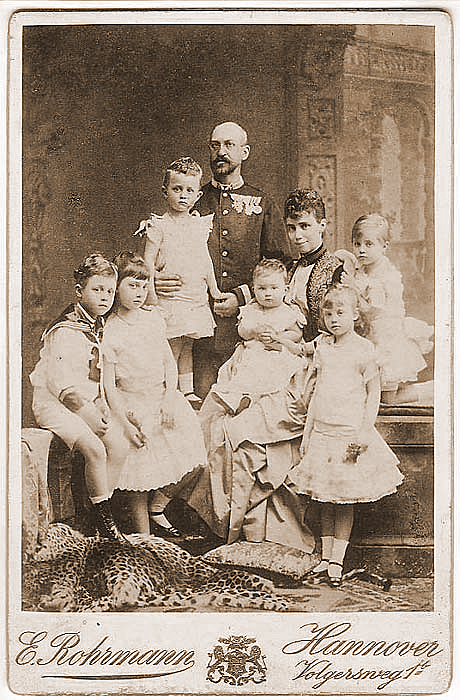by Susan Flantzer © Unofficial Royalty 2016

Credit – Wikipedia
Kingdom of Hanover: In 1714, George, Elector of Hanover, became King George I of Great Britain due to the extinction of the Protestant Stuart line. He remained Elector of Hanover as did his successors King George II and King George III. In 1814, under the terms of the Congress of Vienna, the Electorate of Hanover was raised to the Kingdom of Hanover and King George III also became King of Hanover.
George III’s sons George IV and William IV succeeded him as King of the United Kingdom and King of Hanover. However, because the Kingdom of Hanover followed the Salic Law which did not allow female succession, Queen Victoria who succeeded her uncle William IV as Queen of the United Kingdom, could not become Queen of Hanover. Therefore, Queen Victoria’s paternal eldest surviving uncle Ernest Augustus, Duke of Cumberland became King of Hanover.
King George V, Ernest Augustus’ son, was the last King of Hanover. Hanover backed the losing side in the Austro-Prussian War and was conquered by the Kingdom of Prussia in 1866 and became a Prussian province. Since then, the senior heir of the House of Hanover has been the pretender to the throne of the Kingdom of Hanover. Today the former Kingdom of Hanover is in the German state of Lower Saxony.
********************
Ernest Augustus, King of Hanover, Duke of Cumberland was the fifth of the nine sons and the eighth of the fifteen children of King George III of the United Kingdom and Charlotte of Mecklenburg-Strelitz. He was born at the Queen’s House (now Buckingham Palace) in London, England on June 5, 1771. Queen Charlotte had attended an afternoon reception and then gave birth to Ernest after fifteen minutes of labor. Ernest was christened on July 1, 1771, in the Great Council Chamber at St. James’s Palace in London, England by Frederick Cornwallis, Archbishop of Canterbury. His godparents were:
- Prince Ernst of Mecklenburg-Strelitz (his maternal uncle)
- Prince Moritz of Saxe-Gotha-Altenburg (his paternal great-uncle)
- Hereditary Princess of Hesse-Kassel (first cousin of King George III, born Princess Wilhelmina Caroline of Denmark, wife of the future Wilhelm I, Elector of Hesse)
Ernest had fourteen siblings:
- King George IV (1762 – 1830), married Caroline of Brunswick-Wolfenbüttel, had issue: Princess Charlotte of Wales who died in childbirth as did her child
- Prince Frederick, Duke of York (1763 – 1827), married Frederica of Prussia, no issue
- King William IV (1765 – 1837), married Adelaide of Saxe-Meiningen, no surviving legitimate issue, has illegitimate descendants
- Charlotte, Princess Royal (1766 – 1828), married King Friedrich I of Württemberg, no surviving issue
- Prince Edward, Duke of Kent (1767 – 1820), married Victoria of Saxe-Coburg-Saalfeld, had issue: Queen Victoria, present British Royal Family are his descendants
- Princess Augusta Sophia (1768 – 1840), never married, no issue
- Princess Elizabeth (1770 – 1840), married Friedrich, Landgrave of Hesse-Homburg, no issue
- Prince Augustus Frederick, Duke of Sussex (1773 – 1843), married twice, both in contravention of the Royal Marriages Act of 1772 (1) Lady Augusta Murray, had issue, marriage annulled (2) Lady Cecilia Buggin (later 1st Duchess of Inverness), no issue
- Prince Adolphus, Duke of Cambridge (1774 – 1850), married Augusta of Hesse-Kassel, had issue, present British Royal Family are his descendants through his granddaughter Mary of Teck who married King George V of the United Kingdom
- Princess Mary (1776 – 1857), married Prince William Frederick, Duke of Gloucester, no issue
- Princess Sophia (1777 – 1848), never married, possible illegitimate issue
- Prince Octavius (1779 – 1783), died in childhood
- Prince Alfred (1780 – 1782), died in childhood
- Princess Amelia (1783 – 1810), never married, no issue

Queen Charlotte painted by Benjamin West in 1779 with her 13 eldest children; Credit – http://www.royalcollection.org.uk
Ernest and his siblings were raised by their governess Lady Charlotte Finch who served the Royal Family for over 30 years. Lady Charlotte supervised the royal nursery and was responsible for the princes’ education until they lived in their own households and for the princesses until they turned 21. After leaving the nursery, Ernest lived in a household with his younger brothers Adolphus and Augustus near the royal residence Kew Palace, and the three brothers were educated by private tutors. In 1786, Ernest, Adolphus, and Augustus were sent to the University of Göttingen in Hanover (Germany) under the supervision of Georg Christoph Lichtenberg, a mathematics and physics professor.

Prince Ernest in 1782 by Thomas Gainsborough; Credit – Wikipedia
In 1791, Ernest and Augustus joined the Hanoverian army and received military training from Field Marshal Wilhelm von Freytag. Ernest proved to be an excellent horseman and a good shot. After only two months of training, Field Marshal von Freytag was so impressed by the progress of his pupil that he appointed him a captain in the cavalry.
In March of 1792, Ernest was commissioned as colonel of the 9th Hanoverian Light Dragoons. During the War of the First Coalition (1793-97), Ernest was stationed in Flanders and served under his older brother Frederick, Duke of York, the commander of the combined British, Hanoverian, and Austrian troops. During military action in 1793, Ernest received a saber wound to the head which left him with a disfiguring scar. In the Battle of Tourcoing (1794), Ernest was hit in the left arm by a cannonball, and his eyesight was also affected. He returned to England to recover, the first time he had been back home since 1786. Ernest returned to his military duties in 1787. He was promoted to the following military ranks:
- 1798: Lieutenant General
- 1803: General
- 1813: Field Marshal
- 1801 – 1827: Colonel of the 15th (The King’s Own) Light Dragoons
- 1827 – 1830 Colonel of Royal Regiment of the Horseguards (Blues)
On April 24, 1799, Ernest was created Duke of Cumberland and Teviotdale and Earl of Armagh. He was the least popular of his brothers and he had a less than favorable appearance due to the facial wounds he had received in war. Ernest had a negative reputation, probably unjustifiably. He was accused of being involved in the murder of his valet Joseph Sellis, of having an incestuous affair with his sister Sophia and of being the father of her illegitimate child. It is doubtful that there was any truth to any of those allegations.

Ernest Augustus in an 1823 miniature based on an 1802 portrait by William Beechey. The facial damage from war wounds can be seen; Credit – Wikipedia
While on a visit to his maternal uncle Karl II, Duke of Mecklenburg-Strelitz in 1813, Ernest fell in love with his first cousin Frederica of Mecklenburg-Strelitz. Frederica was the daughter of his mother’s brother Karl II, Duke of Mecklenburg-Strelitz and his first wife, Frederica of Hesse-Darmstadt. Ernest’s cousin Frederica had a bit of a history that disturbed Ernest’s mother, Queen Charlotte. In 1793, Frederica married Prince Ludwig Karl of Prussia, the second son of King Friedrich Wilhelm II of Prussia. The marriage was unhappy, but the couple had three children. Three years after the marriage, Ludwig Karl died from diphtheria.
In 1797, Frederica and Ernest’s younger brother Prince Adolphus, Duke of Cambridge became unofficially engaged. It is unclear whether Frederica jilted Adolphus or if King George III, under pressure from Queen Charlotte, refused to consent to the marriage. In 1798, Frederica became pregnant and the father was Prince Friedrich Wilhelm of Solms-Braunfels. The couple married in order to avoid a scandal, and two months later, Frederica gave birth to a daughter who lived only eight months. Frederica and her second husband had five more children who survived to adulthood. Friedrich Wilhelm was an alcoholic and had to quit the military for health reasons. He lost his income and even his brother advised Frederica to divorce. She was initially against it, but when she met Ernest in 1813, she too wanted the divorce. Before the divorce could be arranged, Friedrich Wilhelm died in April 1814. For some, Friedrich Wilhelm’s death was a little too convenient, and they suspected that Frederica had poisoned him.
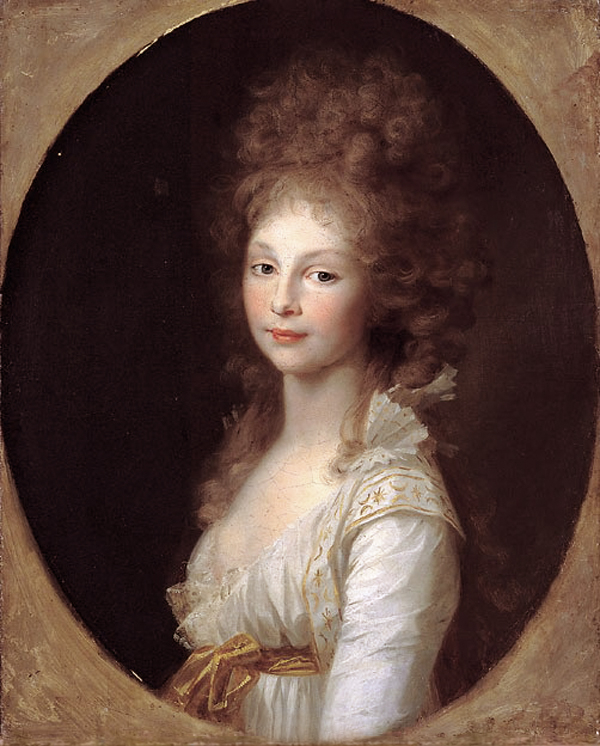
Frederica of Mecklenburg-Strelitz in 1796 by Johann Friedrich August Tischbein; Credit – Wikipedia
Ernest’s eldest brother George, Prince of Wales had become Prince Regent in 1811 due to the incapacitation of King George III, and so he gave his official permission for the marriage. Ernest and Frederica became engaged in August of 1814. They were married on May 29, 1815, at the Palace of Neustrelitz. The British Privy Council recommended that a second marriage be performed when the couple arrived in England because any children born of the marriage could eventually be close to the succession. Ernest arrived back in England in June to make plans for the second marriage without Frederica, having left her in Neustrelitz. Shortly after his arrival, Ernest received a letter from his mother, Queen Charlotte. The queen regretted that she must refuse to receive Frederica because it was known in England that Frederica had broken her engagement with Adolphus and, to quote the queen, ” the unfavorable impression which the knowledge of those circumstances had made here.” Of course, Ernest was shocked that his mother would do this, but things got worse. Queen Charlotte warned the rest of the family that she would be severely displeased if they received Frederica.
Nevertheless, Ernest returned to Neustrelitz to escort Frederica to England, where the second wedding ceremony was held on August 29, 1815, at Carlton House in London, England, the Prince Regent’s residence. Ernest’s sisters felt that they could not defy their mother, but his elder brothers George, Frederick, William, and Edward attended the ceremony. Ernest and Frederica had one son and two stillborn daughters:
- Princess Frederica of Cumberland (January 1817), stillborn
- Unnamed daughter (April 1818), stillborn
- George V, King of Hanover, Duke of Cumberland (1819 – 1878), married Marie of Saxe-Altenburg; had issue
Ernest and Frederica’s son, Prince George of Cumberland at birth, was born amidst the race for an heir to the British throne in the third generation. The death of Princess Charlotte of Wales in childbirth in 1817 left King George III without any legitimate grandchildren. Prince George was born three days after the birth of the eventual heir, Alexandrina Victoria (Queen Victoria), who was ahead of her cousin in the succession by being the child of King George III’s fourth son, Prince Edward, Duke of Kent. After Queen Victoria’s accession to the throne in 1837, Ernest and his son George remained first and second in the line of succession to the British throne until Queen Victoria’s first child was born. Today their descendant Ernst August V, Prince of Hanover is the senior male-line descendant of King George III and the Head of the House of Hanover.
On June 20, 1837, Ernest’s eldest surviving brother King William IV died and the only child of Prince Edward, Duke of Kent succeeded her uncle as Queen Victoria. Upon the accession of Queen Victoria, Ernest became King of Hanover. Up until that point, Hanoverian kings of the United Kingdom were also Electors or Kings of Hanover. However, Hanover followed the Salic Law which did not allow female succession. Ernest Augustus, as the eldest surviving son of King George III, became King of Hanover, his wife became Queen Consort of Hanover, and his son George became Crown Prince of Hanover. Ernest arrived in Hanover (Germany) eight days after his brother King William IV died on June 20, 1837, to take up his duties as the new King of Hanover. He only returned to England once, when he attended the wedding of his niece Princess Augusta of Cambridge on June 18, 1843.
When King Ernest Augustus of Hanover (Ernst August in German) arrived in his kingdom on June 28, 1837, he was greeted by booming cannons, church bells ringing, and cheering people who were glad to have their king in his kingdom after years of rule by viceroys. However, Ernest soon proved unpopular with his anti-liberal style of government. In November of 1837, Ernest issued a patent declaring the 1833 liberal constitution void and restoring the more conservative 1819 constitution. This patent required all officeholders, including professors at the University of Göttingen, to take an oath of allegiance to the King. Seven professors, called the Göttingen Seven, including the two Brothers Grimm, Jacob and Wilhelm, refused to take the oath and encouraged others to protest against the King’s patent. Since they did not take the oath, the Göttingen Seven lost their positions, and the King expelled the three most responsible (including Jacob Grimm) from Hanover.
Queen Frederica died after a short illness on June 29, 1841, at the age of 63. Ernest commissioned the architect Georg Ludwig Friedrich Laves to build a mausoleum for his wife and himself. The mausoleum was built from 1842 – 1847 in the garden of the chapel at Schloss Herrenhausen, which was destroyed during World War II. A decision to rebuild the palace was made in 2007, and reconstruction was completed in 2013. Today the mausoleum is in the Berggarten, part of the Herrenhausen Gardens.
The Revolutions of 1848, which led to the fall of King Louis Philippe I of the French, encouraged citizens of Hanover and citizens of other German kingdoms, principalities, and duchies to demand German national unity, freedom of the press, and freedom of assembly. Ernest was initially reluctant to make concessions, but the citizens’ demands threatened to spark a revolution against the monarchy. To prevent a revolution, Ernest agreed to reforms. He appointed liberal politician Johann Carl Bertram Stüve, the deputy of the national assembly in the Kingdom of Hanover and liberal interior minister to create a modern constitution for the Kingdom of Hanover. The new constitution, which came into effect on September 5, 1848, guaranteed freedom of the press, freedom of assembly, the separation of the judiciary and administration, and the equality of all religions. Because of the freedoms granted in the 1848 constitution, Ernest’s popularity greatly increased.

Ernest Augustus, King of Hanover; Credit – Wikipedia
Ernest Augustus died on November 18, 1851, after a short illness. Of his fifteen siblings, only Princess Mary, Duchess of Gloucester survived him. 30,000 people passed by his coffin as he lay in state in the throne room of Schloss Herrenhausen. On November 25, 1851, his funeral was held in the Schloss Herrenhausen chapel. Ernest was then buried in the mausoleum he had built when his wife died.

Mausoleum in the Berggarten, part of the Herrenhausen Gardens; Credit – Wikipedia

Interior of the Mausoleum in the Berggarten with the tombs of Queen Frederica and King Ernest Augustus, about 1861; Credit – Wikipedia
This article is the intellectual property of Unofficial Royalty and is NOT TO BE COPIED, EDITED, OR POSTED IN ANY FORM ON ANOTHER WEBSITE under any circumstances. It is permissible to use a link that directs to Unofficial Royalty.
Unofficial Royalty Kingdom of Hanover Resources
- Kingdom of Hanover Index
- Hanoverian Royal Dates
- Hanover Royal Burial Sites
- Profiles: Hanoverian Rulers and Consorts
- Rulers of Hanover
Works Cited
“Ernest Augustus, King of Hanover.” Wikipedia. N.p.: Wikimedia Foundation, 21 July 2016. Web. 9 Aug. 2016.
“Frederica of Mecklenburg-Strelitz.” Wikipedia. N.p.: Wikimedia Foundation, 28 May 2016. Web. 11 Aug. 2016.
Van Der Kiste, John. George III’s Children. Trowbridge: Alan Sutton Publishing Limited, 1999. Print.
Williamson, David. Brewer’s British Royalty. London: Cassell, 1996. Print.
















